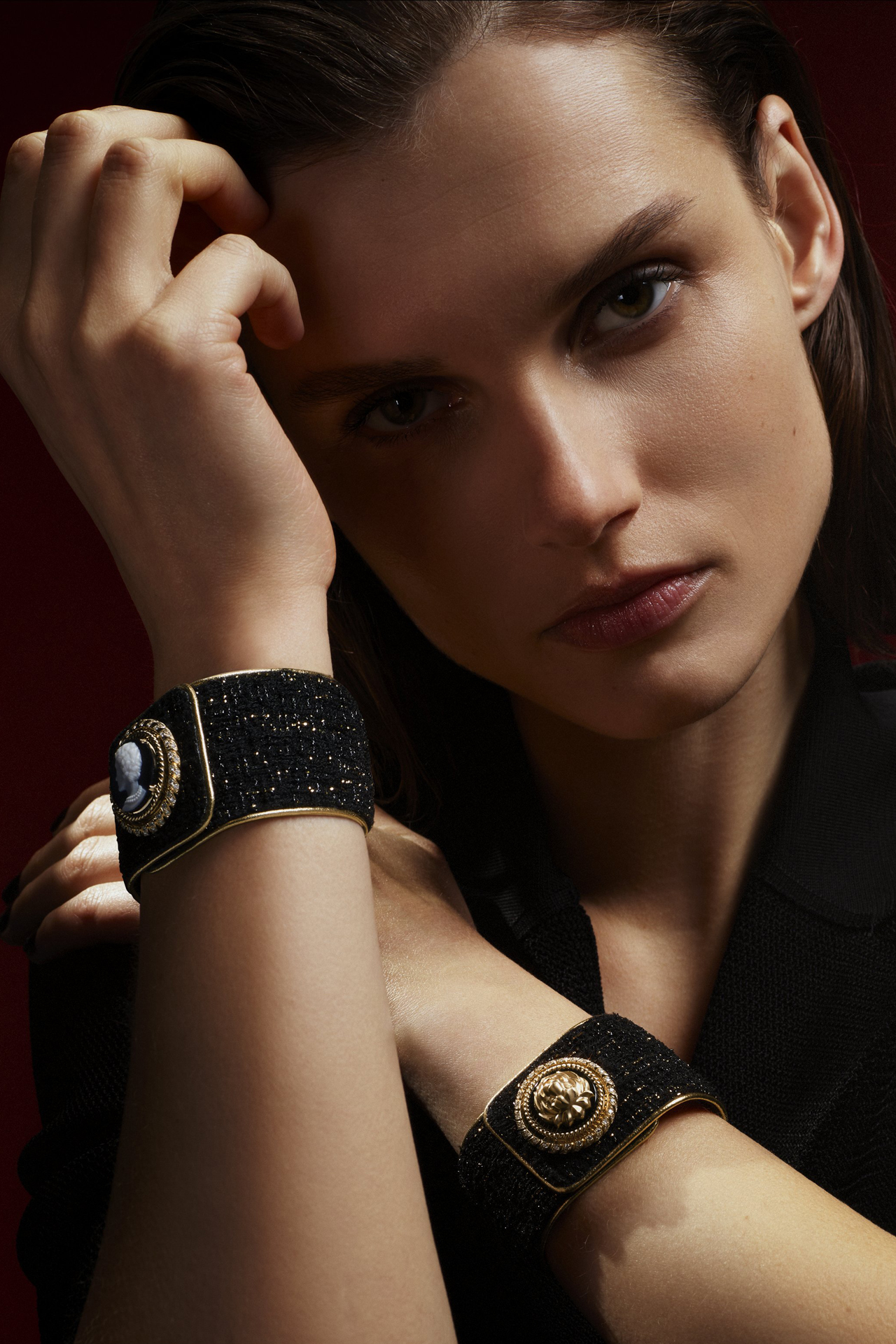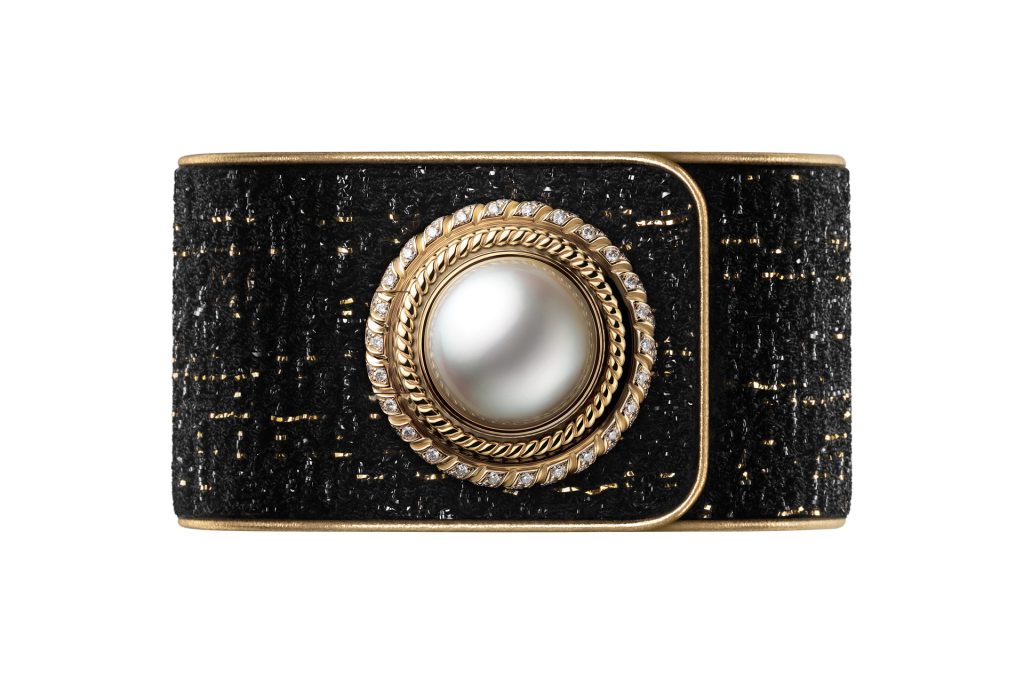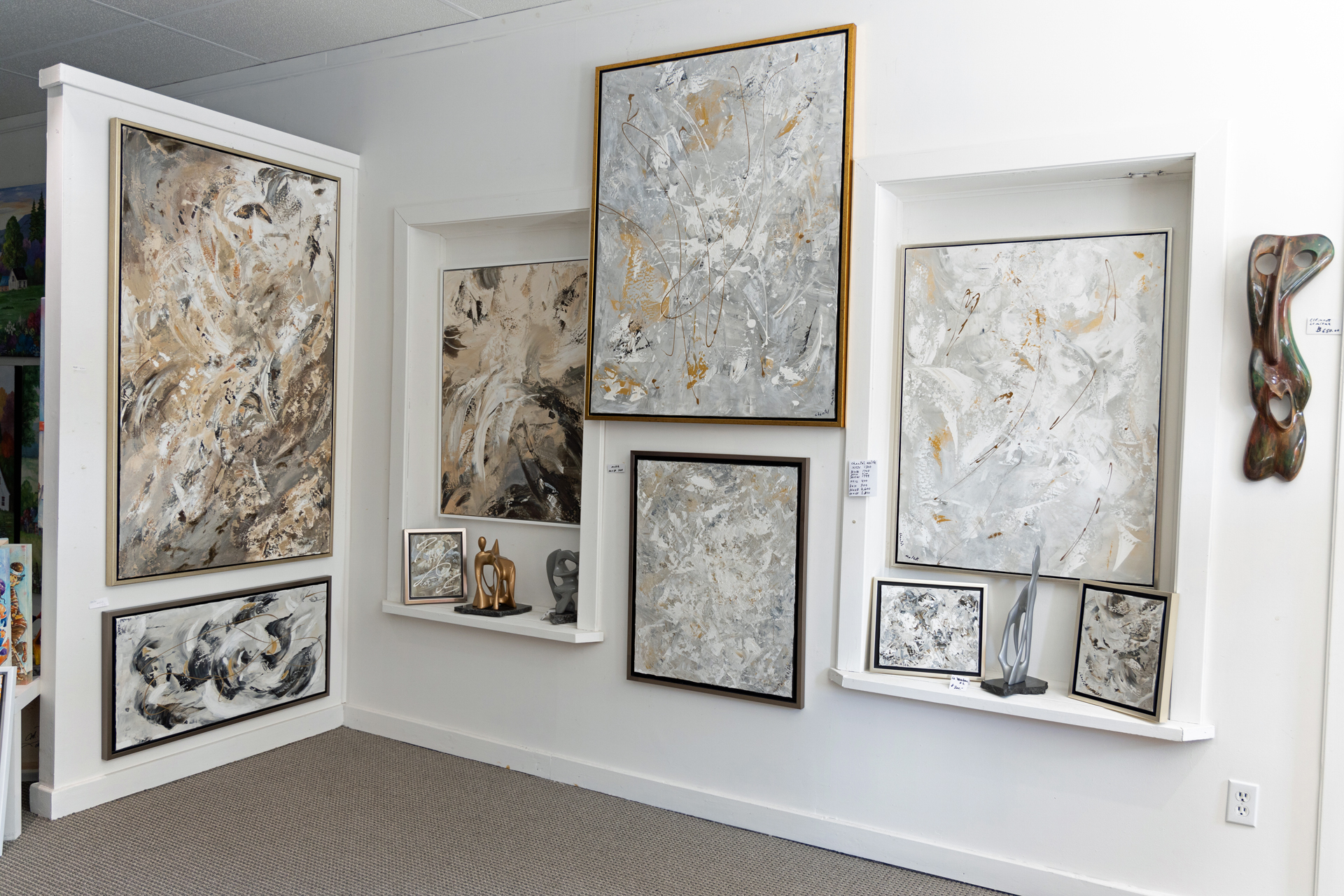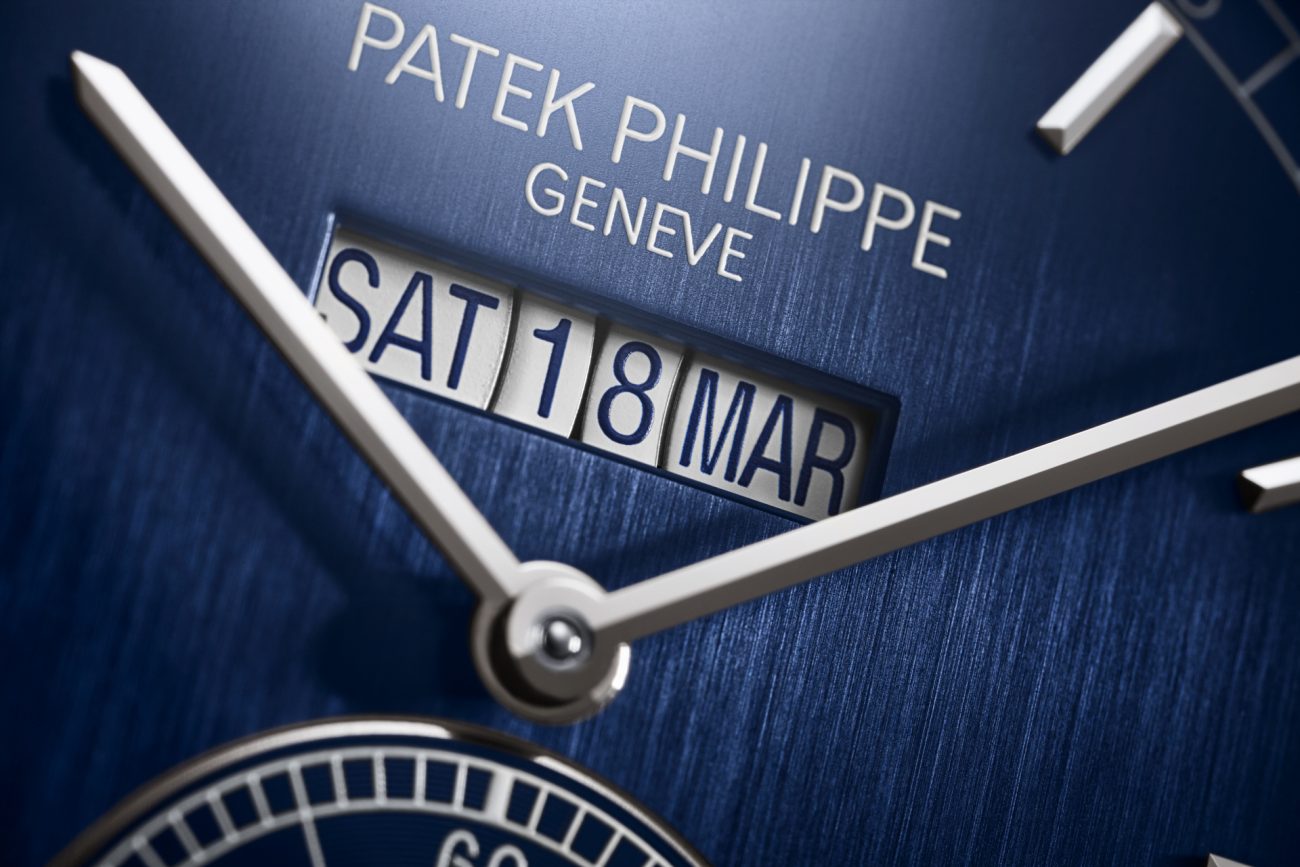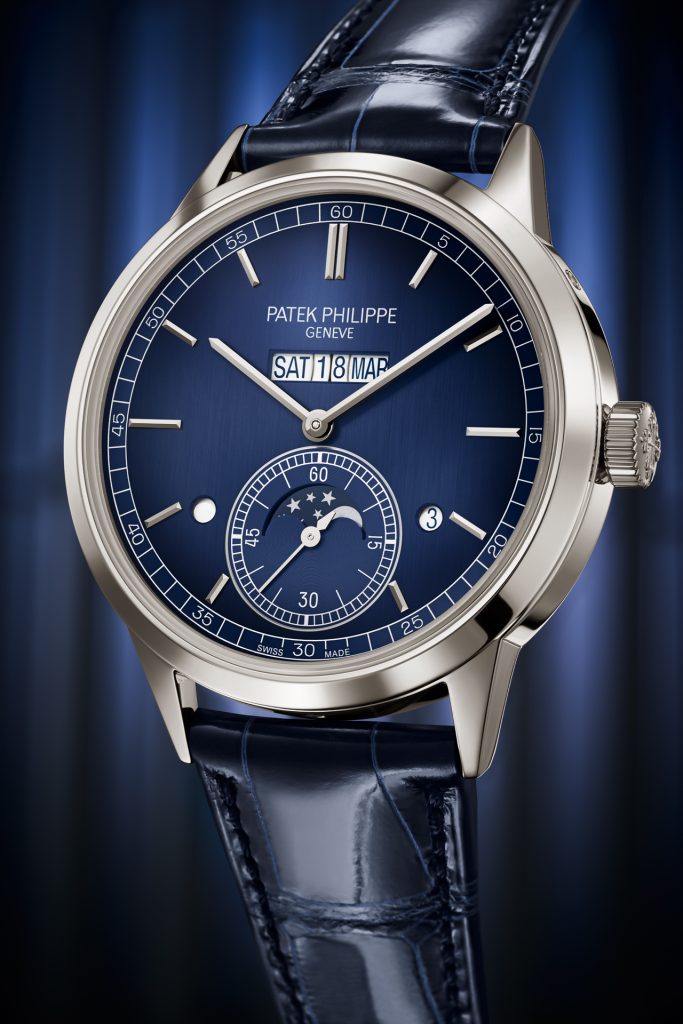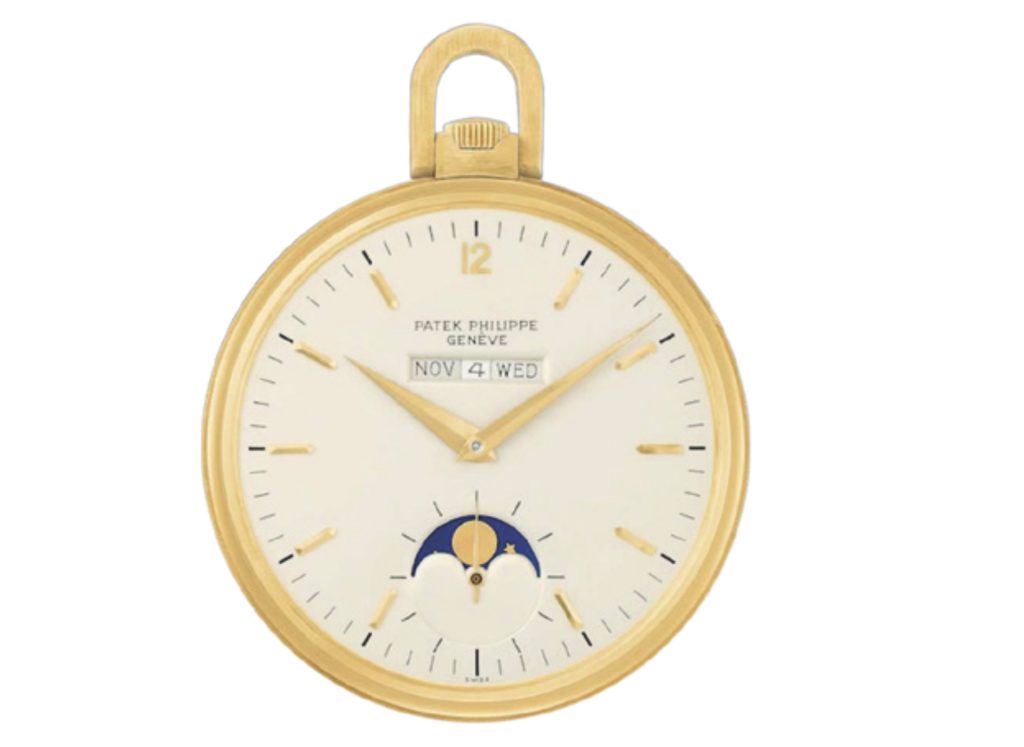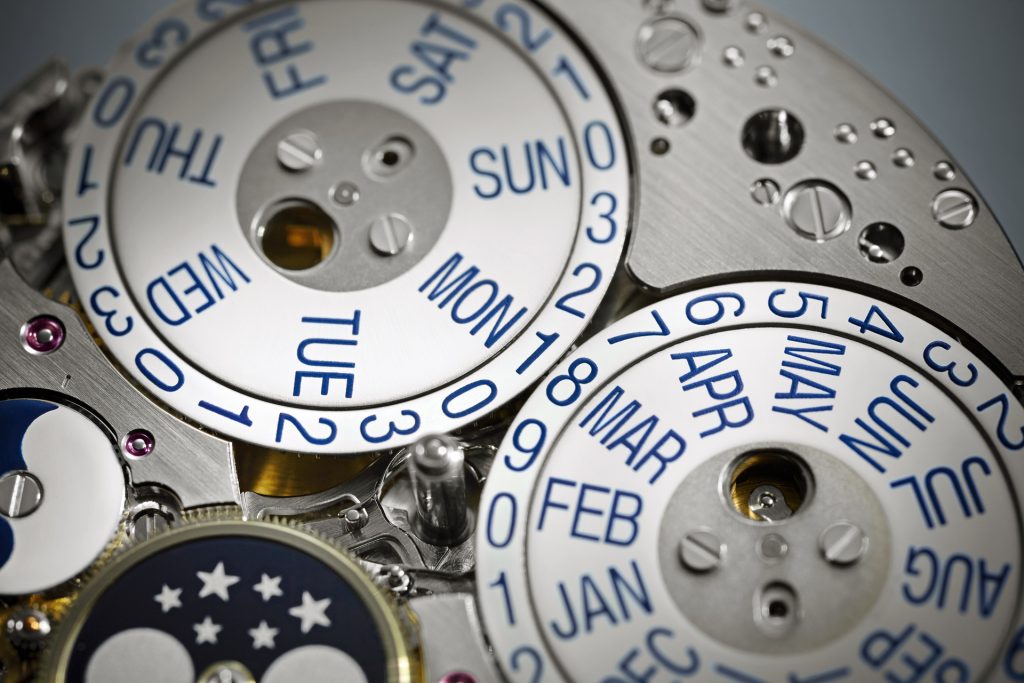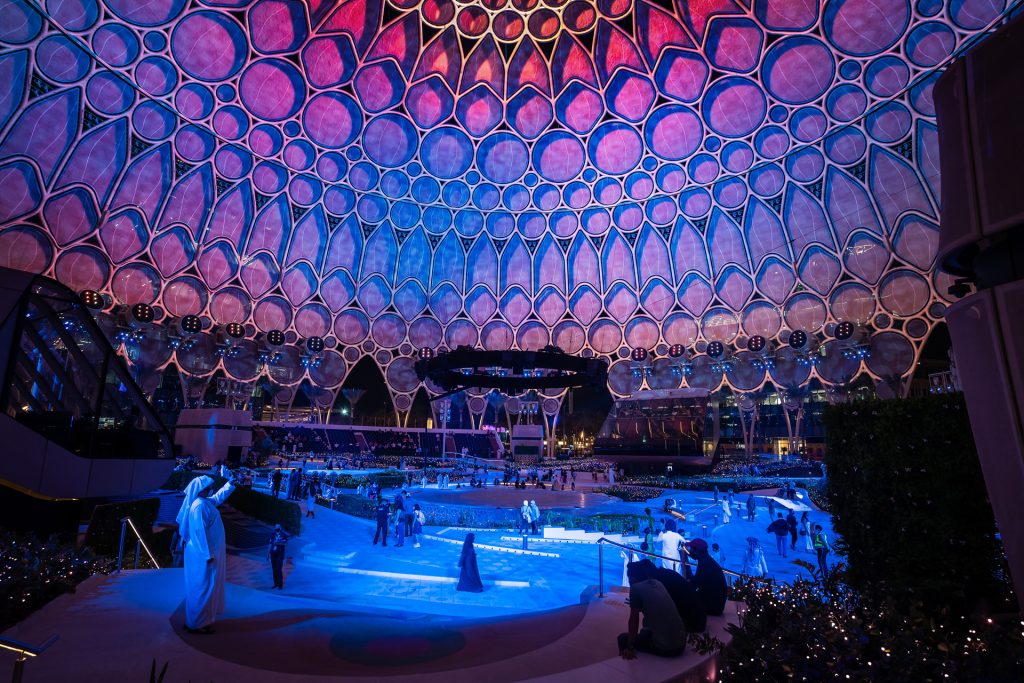As every admirer of the Chanel style (or Chanel “allure”, to use the technical term) knows perfectly well, the maison follows its own rigorous stylistic grammar, whose elements were established very early on by Gabrielle Chanel. These elements include the essential black and white, the famous Chanel beige, Breton stripes, the two-piece suit, tweed, quilting, pearls, lions, the camellia… as well as chains, brocade trim and buttons.
In collaboration with Europa Star
A functional flourish
Yes, buttons. But, aren’t they a minor detail? No, they’re far more important than that! The Chanel button is not just a precious object in its own right, a diminutive jewel, exquisitely and artistically crafted – it is also rigorously functional, in accordance with the strict grammatical rules dictated by Mademoiselle herself: “Every button must have a buttonhole”. “Gabrielle Chanel thus conferred on the button an unparalleled nobility,” explains Arnaud Chastaingt, director of Chanel’s Watchmaking Creation Studio. “She magnified an ordinary, unremarkable object and elevated it to the level of a jewel. For her, it was a canvas for creativity in its own right, but it absolutely had to retain its function.”
The exceptional variety of Chanel buttons created over the decades has attracted many collectors. In the very early days, button creation was entrusted to a talented craftsman, Georges Desrues, who in 1929 set up the company that bears his name, and which became Chanel’s primary supplier from 1965. Every day, almost 4000 buttons (each of which requires around ten operations) are moulded, sculpted, carved, polished, dyed, coated and enamelled in its workshops, using a combination of modern technology and traditional craftsmanship. Some twenty artistic crafts are employed, and Chanel was able to preserve them for posterity when it bought the Maison Desrues in 1984. “It is a unique tool in the world of luxury ready-to-wear,” confirms director of operations Stéphane Berthélémy.
Mademoiselle Privé Bouton Ganse de diamants
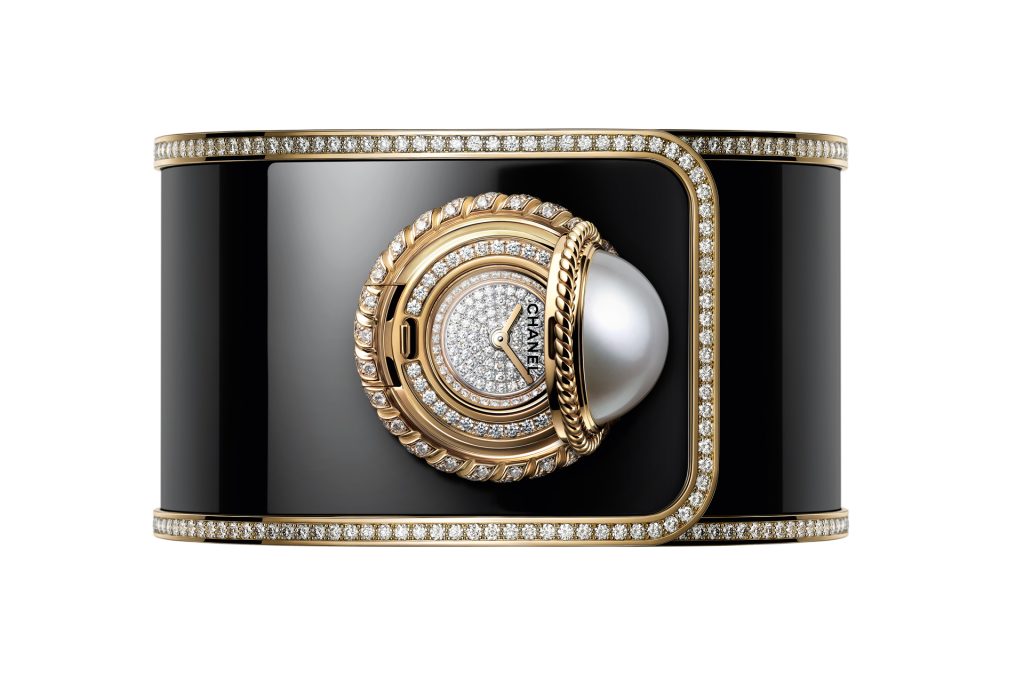
Mademoiselle Privé Bouton Ganse de diamants. Numbered and limited edition of 5 pieces. 18K yellow gold button adorned with a half white Australian cultured pearl (15 mm). Outer 18K yellow gold cord set with 52 brilliant-cut diamonds (~0.46 carat), inner 18K yellow gold cord. 18K white gold dial set with 142 brilliant-cut diamonds (~0.52 carat). Gold-finished hands. 18K white gold rigid cuff with a black coating and 18K yellow gold trim set with 316 brilliant-cut diamonds (~3.89 carats). High-precision quartz movement.
Mademoiselle Privé Bouton Perle
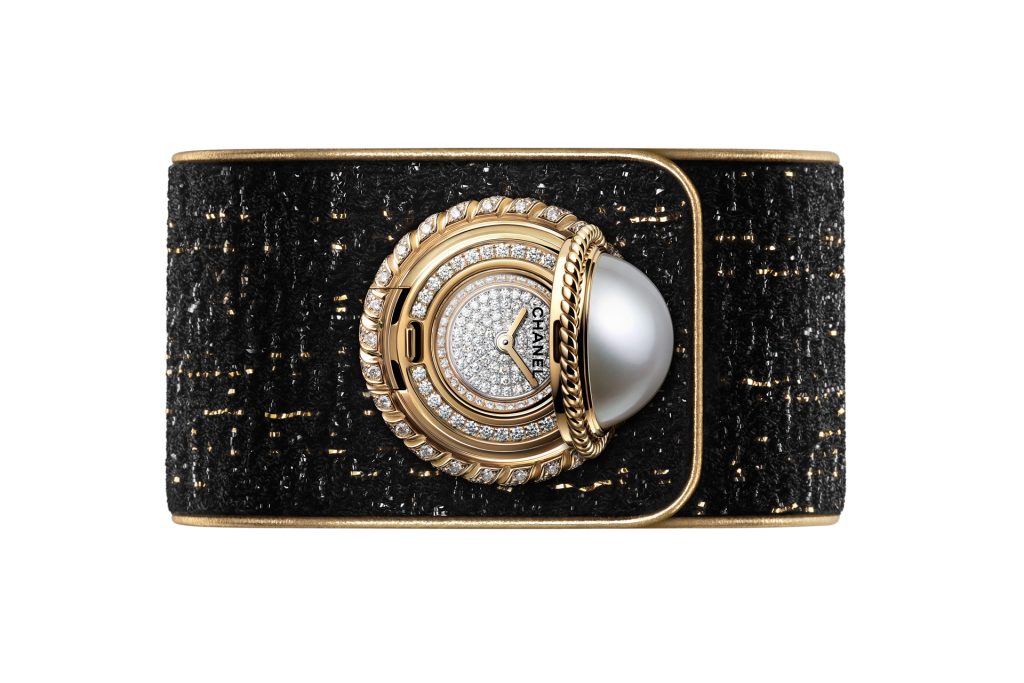
Mademoiselle Privé Bouton Perle. 18K yellow gold button adorned with a half white Australian cultured pearl (15 mm). Outer 18K yellow gold cord set with 52 brilliant-cut diamonds (~0.46 carat), inner 18K yellow gold cord. 18K white gold dial set with 142 brilliant-cut diamonds (~0.52 carat). Gold-finished hands. Black and gold tweed cuff with a golden calfskin trim and a black calfskin lining. High-precision quartz movement.
Couture time
“For me, the idea of a ‘button’ watch was one of those creative obsessions that I couldn’t let go of – it just seemed self-evident,” confirms Arnaud Chastaingt. “I had a dream of the button as timepiece.” The dream is all the more unconstrained because, as he correctly points out: “30 years ago, Chanel came from the world of couture, and invited itself without permission into the closed world of watchmaking.” Onto this world, which at the time was stylistically conservative and highly segmented, Chanel succeeded in imposing its own grammar, beginning with black and white, gradually introducing the rest of its codes, and translating them into watchmaking.
So, a button as watch… A watch born out of couture? What could be more natural? Arnaud Chastaingt, obsessively pursuing his research, had the idea of “unpicking the sleeve of a jacket, and keeping only the cuff with its buttonhole.” And thus the architecture of the bracelet was born: a soft tweed cuff edged with a slim golden leather binding, that wraps around the wrist and fastens with… a button. The button is functional, as per the rule. But not only does it have a buttonhole, it also covers and conceals a watch. “Style comes first, time comes later, whether you like it or not,” concludes Arnaud Chastaingt.
“For me, the idea of a ‘button’ watch was one of those creative obsessions that I couldn’t let go of – it just seemed self-evident.” – Arnaud Chastaingt, director of Chanel’s Watchmaking Creation Studio
Mademoiselle Privé Bouton décor Lion

Mademoiselle Privé Bouton décor Lion. Limited edition of 55 pieces. 18K yellow gold button adorned with a sculpted gold lion motif. Outer 18K yellow gold cord set with 52 brilliant-cut diamonds (~0.46 carat), inner 18K yellow gold cord. 18K white gold dial set with 142 brilliant-cut diamonds (~0.52 carat). Gold-finished hands. Black and gold tweed cuff with a golden calfskin trim and a black calfskin lining. High-precision quartz movement.
Mademoiselle Privé Bouton décor Camélia
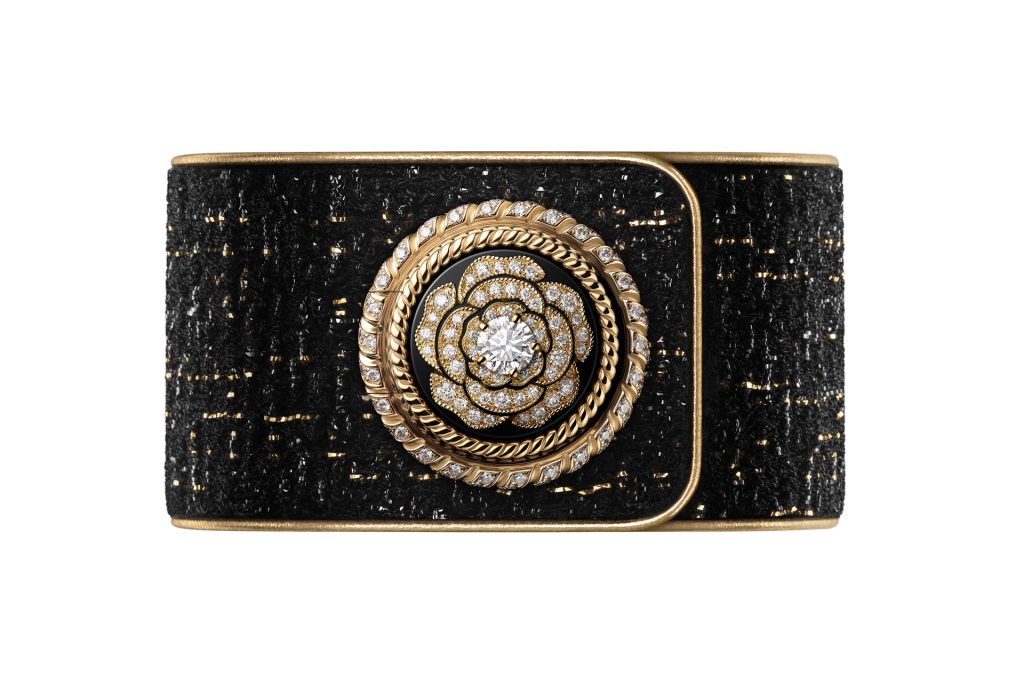
Limited edition of 55 pieces. 18K yellow gold button adorned with a camellia motif fully set with 50 brilliant-cut diamonds (~0.38 carat) and a central brilliant-cut diamond (~0.5 carat). Outer 18K yellow gold cord set with 52 brilliant-cut diamonds (~0.46 carat), inner 18K yellow gold cord. 18K white gold dial set with 142 brilliant-cut diamonds (~0.52 carat). Gold-finished hands. Black and gold tweed cuff with a golden calfskin trim and a black calfskin lining. High-precision quartz movement.
Creative wealth
This novel architecture, with its cuff and its button-watch, opens up a wealth of creative prospects. The precious button – and over the course of its history Chanel has created countless examples – lends itself to so many possibilities that the list is virtually infinite. The Mademoiselle Privé Bouton watch will definitely not be a one-off. The collection opens with a selection of buttons created from yellow gold, diamonds, pearls and agate. It encompasses lions, camellias and the byzantine cross. The iconic profile of Mademoiselle Chanel appears as a cameo, carved from onyx. The tweed cuff is quilted and transformed into white gold, set with diamonds. In 2021, Gabrielle Chanel’s profile is revealed on a carved yellow gold button. The cuff is in black leather, with a quilted motif trimmed in golden calfskin.
Mademoiselle Privé Bouton décor Byzantin
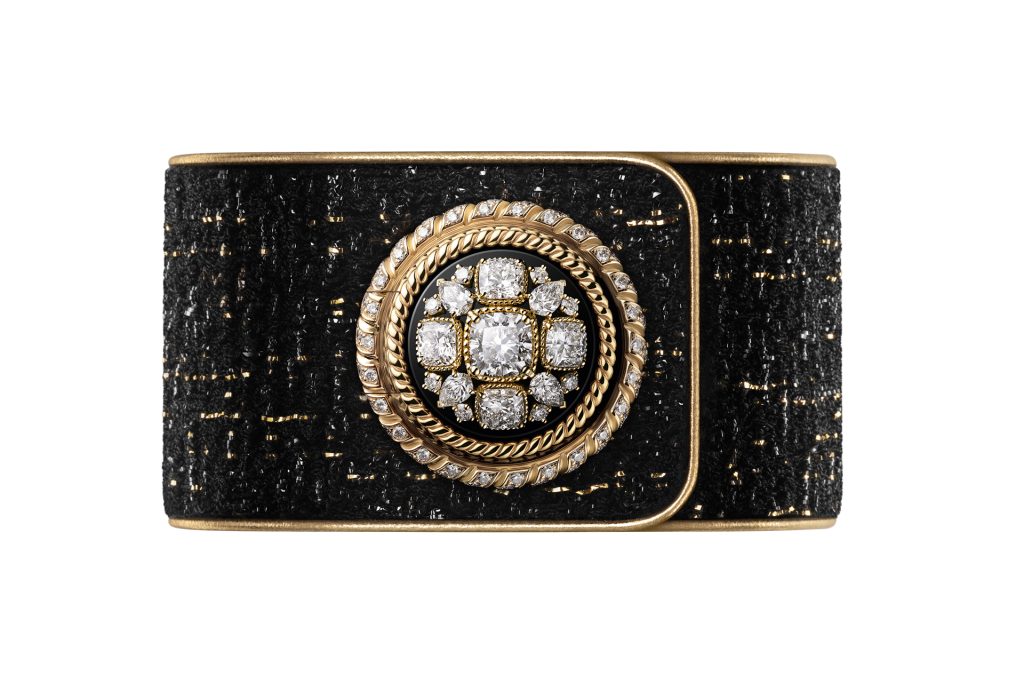
Numbered and limited edition of 5 pieces. 18K yellow gold button adorned with a byzantine motif set with 1 cushion-cut diamond (~1.5 carat), 4 cushion-cut diamonds (~2 carats), 4 pear-cut diamonds (~0.65 carat) and 8 brilliant-cut diamonds (~0.24 carat). Outer 18K yellow gold cord set with 52 brilliant-cut diamonds (~0.46 carat), inner 18K yellow gold cord. 18K white gold dial set with 142 brilliant-cut diamonds (~0.52 carat). Gold-finished hands. Black and gold tweed cuff with a golden calfskin trim and a black calfskin lining. High-precision quartz movement.
Mademoiselle Privé Bouton Camée
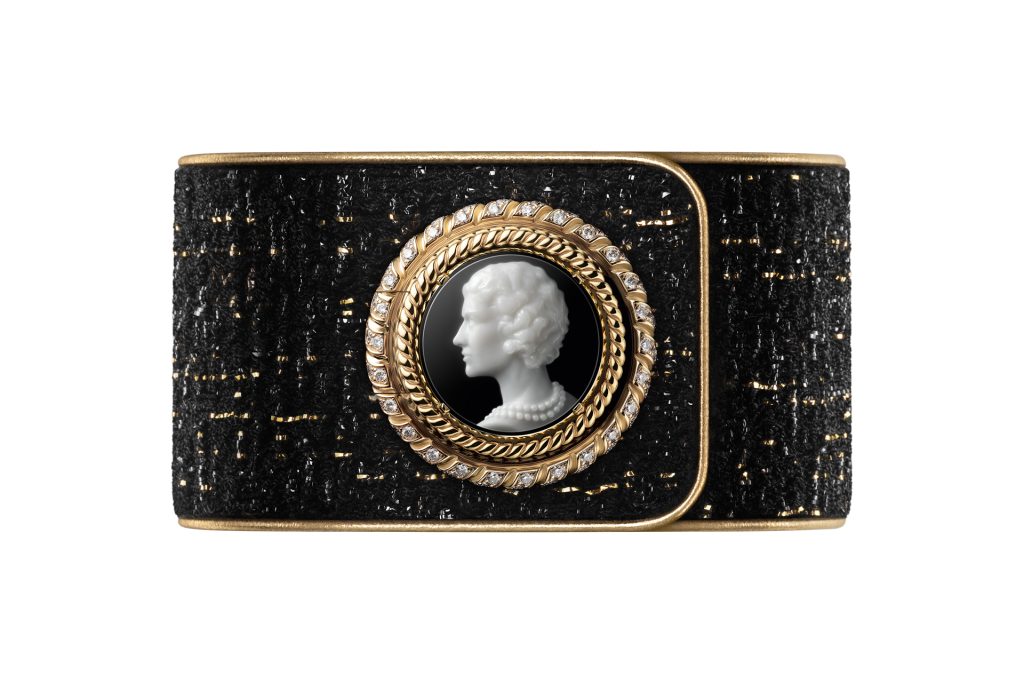
Mademoiselle Privé Bouton Camée. Numbered and limited edition of 5 pieces. 18K yellow gold button adorned with an cameo depicting the profile of Gabrielle Chanel. Outer 18K yellow gold cord set with 52 brilliant-cut diamonds (~0.46 carat), inner 18K yellow gold cord. 18K white gold dial set with 142 brilliant-cut diamonds (~0.52 carat). Gold-finished hands. Black and gold tweed cuff with a golden calfskin trim and a black calfskin lining. High-precision quartz movement.
Novelty 2021
Mademoiselle Privé Bouton décor Gabrielle
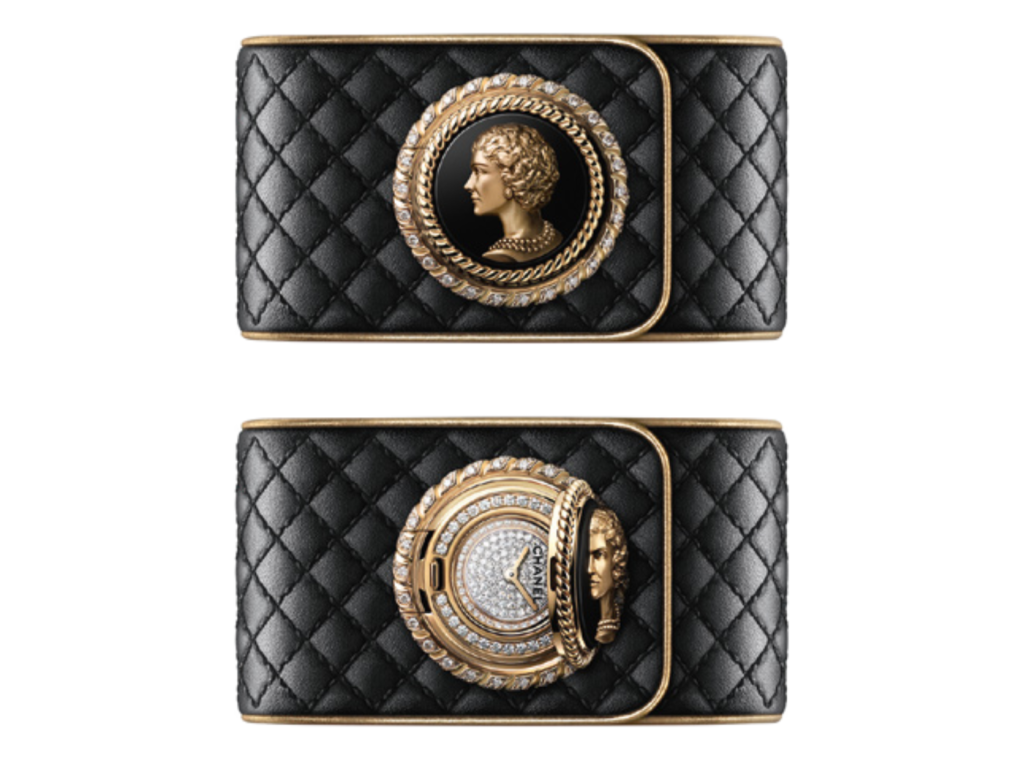
Novelty 2021 – Limited edition of 55 pieces. 18K yellow gold button adorned with a carving depicting the profile of Gabrielle Chanel. Outer cord in 18K yellow gold set with 52 brilliant-cut diamonds (~0.46 carat). Dial in 18K white gold set with 142 brilliant-cut diamonds (~0.52 carat). Cuff in black leather with a quilted motif, trimmed in golden calfskin. High-precision quartz movement.
Mademoiselle Privé
The Bouton watch is the latest to take its place in the Mademoiselle Privé collection (whose name comes from the sign on the door to Gabrielle Chanel’s workshop). As Arnaud Chastaingt explains, Mademoiselle Privé represents “the most intimate side of Chanel haute horlogerie, the most feminine. And perhaps the least well-known.” The Mademoiselle Privé collection, which was launched in 2012 as a showcase for the artistic crafts, includes some of Chanel’s finest and most precious watchmaking creations. Take, for example, the first Mademoiselle Privé watches, inspired by Coromandel screens, and reproduced in breathtaking enamel by Anita Porchet. There are camellias sculpted from mother-of-pearl, skeletonized or paved in diamonds, a parure of petals against a backdrop of enamel, mother-of-pearl marquetry, onyx and sculpted gold, labyrinths of diamonds, a camellia that rotates, or is picked out in gold thread and tiny beads, a soaring comet, aventurine dials…
The Mademoiselle Privé Bouton watch takes its place among these stunning creations, and will no doubt leave its mark on Chanel’s watchmaking. It is a perfect fit, because it is an utterly coherent stylistic interpretation of the Chanel codes. And its legitimacy is beyond question. Who other than Chanel could be behind the tweed, the buttonhole and its button, and all the symbols? Arnaud Chastaingt naturally agrees, noting that the Bouton watch is “a curiosity, an uncomplicated creation in the watchmaking world, but an obvious next step in the world of Chanel.” It’s also an obvious next step for admirers of Mademoiselle Chanel.
Mademoiselle Privé represents “the most intimate side of Chanel haute horlogerie, the most feminine. And perhaps the least well-known.” – Arnaud Chastaingt, directeur du studio de Création de l’Horlogerie de Chanel
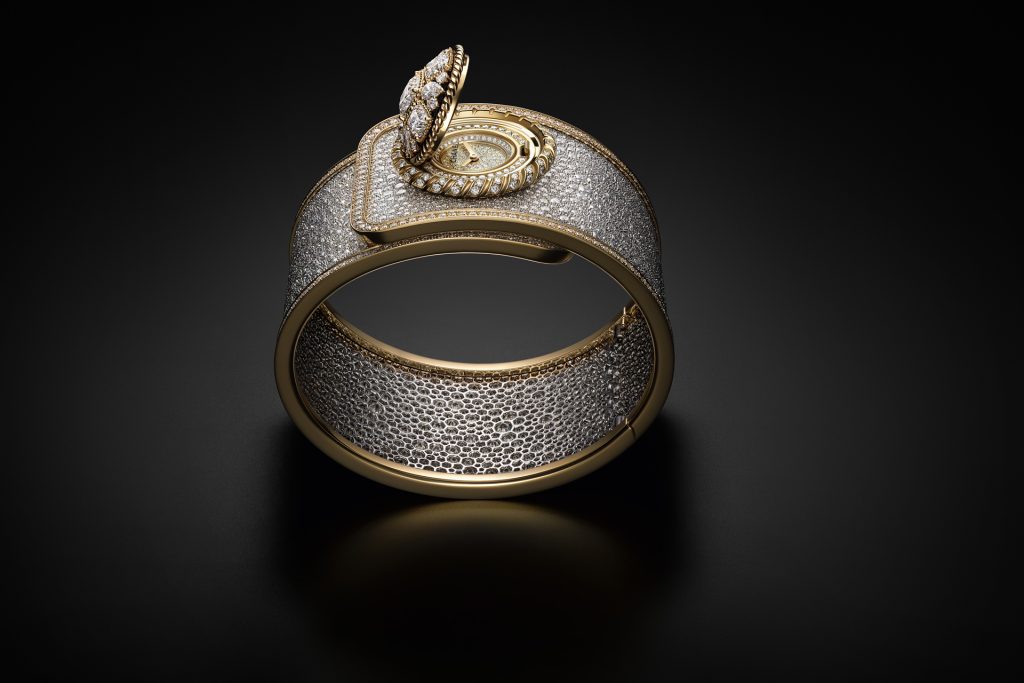
Mademoiselle Privé Bouton serti neige. Unique piece. 18K yellow gold button adorned with a byzantine motif set with 1 cushion-cut diamond (~1.5 carat), 4 cushion-cut diamonds (~2 carats), 4 pear-cut diamonds (~0.65 carat) and 8 brilliant-cut diamonds (~0.24 carat). Outer 18K yellow gold cord set with 52 brilliant-cut diamonds (~0.46 carat), inner 18K yellow gold cord. 18K white gold dial set with 142 brilliant-cut diamonds (~0.52 carat). Gold-finished hands. 18K white gold rigid cuff snow-set with 1963 brilliant-cut diamonds (~39.88 carats) and an 18K yellow gold trim set with 316 brilliant-cut diamonds (~4 carats). High-precision quartz movement.
Text: Pierre Maillard





